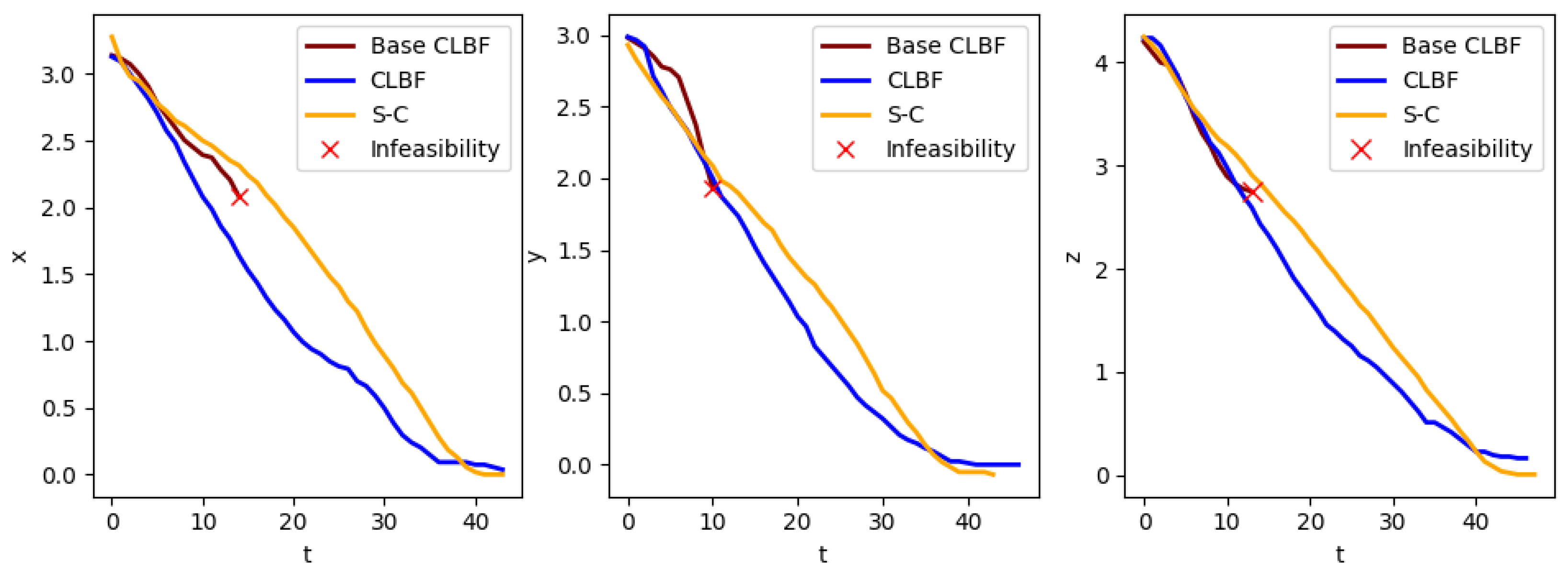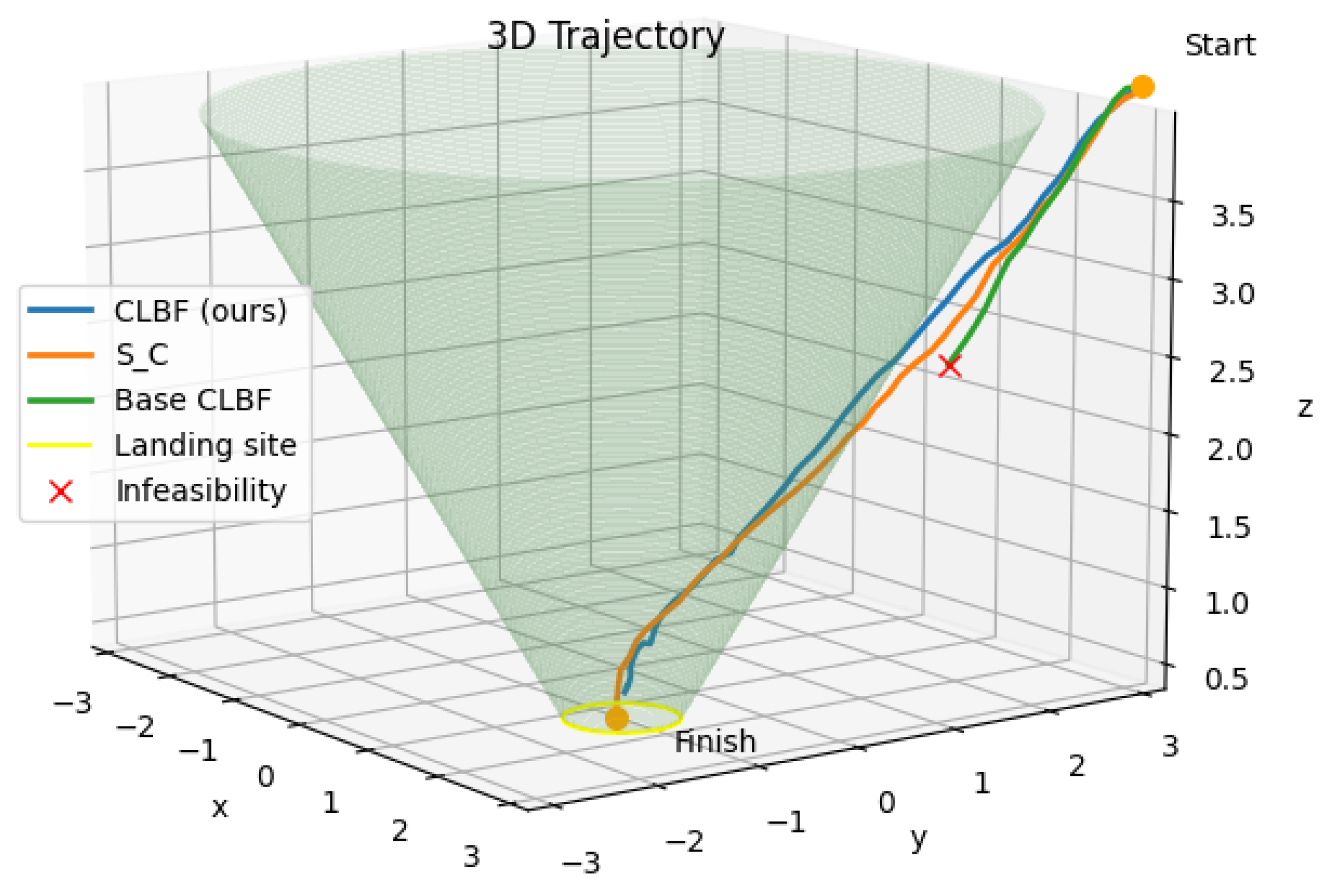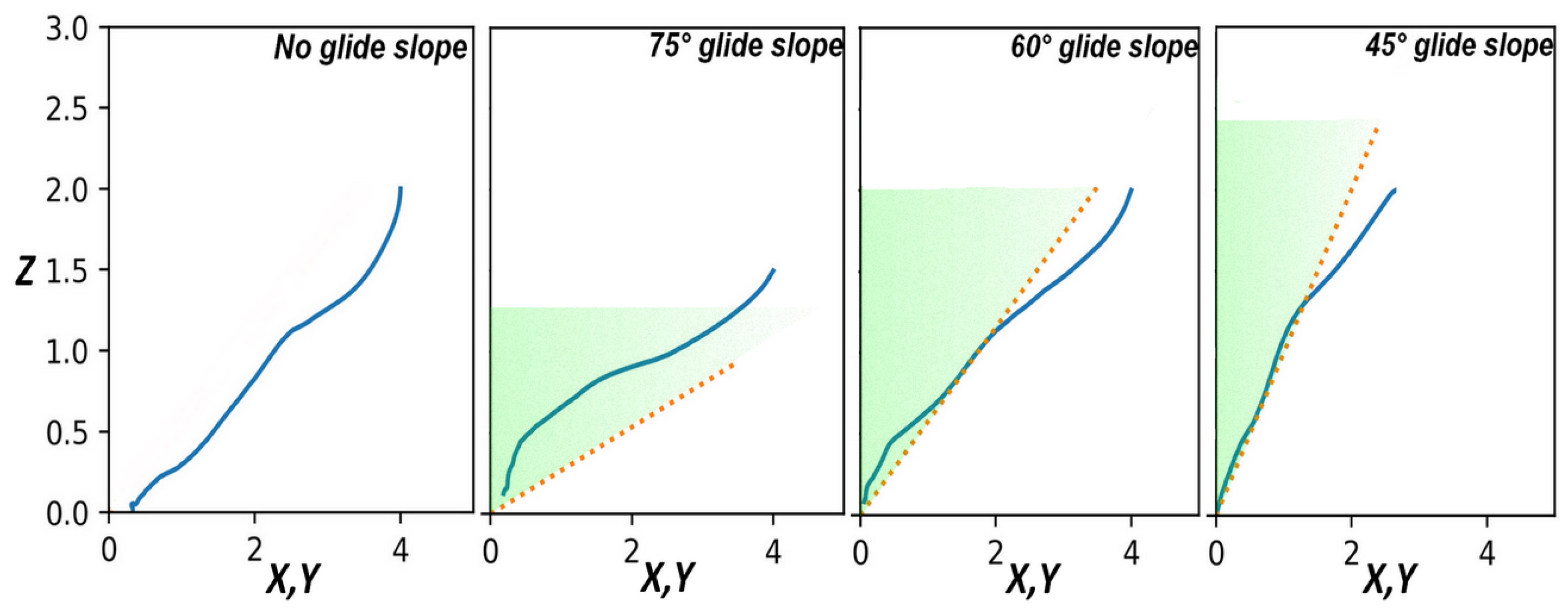1. Introduction
Since the mid-1950s, fast technological advancements have been significantly influenced by the demands of the automotive, robotics, and aerospace industries for precision, reliability, and robustness. With this advancement, modern control theory emerged with multiple techniques to handle complex uncertain systems, leveraging digital computers to perform complex calculations. Unlike classical control theory, which relies heavily on model simplifications and frequency domain techniques, modern control theory focuses on using state-space methods and various estimation techniques like optimal and adaptive control to control complex dynamic systems. Modern techniques were enhanced to be more robust and reliable over time, such as nonlinear model predictive control or model-free adaptive control [
1,
2,
3,
4]. Nevertheless, these techniques still have some shortcomings such as model dependency, computational complexity, and implementation challenges.
Researchers have since worked on new forms of model predictive control which leverage the use of a sequence of techniques like linearization and discretization to generate an optimal control problem that can be iteratively solved like model predictive control. These techniques offer excellent reliability and robustness but still suffer from computational cost and complexity in real-time implementation. The work in [
5,
6,
7] synthesizes the second-order cone program (SOCP), conditionally enforced constraints, and linearization and discretization procedures to transform highly complex nonlinear systems with non-convex state and control into a convexified problem and demonstrates its performance on the 6DoF powered descent guidance problem as a feed-forward trajectory generation problem.
Although successive convexification (SCvx) can provide a real-time control solution for complex systems, it has some significant drawbacks. First, linearization and discretization in a real-time implementation abstract the higher-order features of the problem, rendering the convex model inadequate outside the nominal states. This abstraction possibly raises convergence issues, lowers the confidence in maintaining safety constraints, or even leads to unstable control behavior. Second, SCvx can encounter infeasibility and thus requires good initialization, which can be challenging to acquire for some nominal states, especially for systems with fast dynamics, making SCvx vulnerable to disturbances and model uncertainties. Ultimately, as SCvx requires iteratively solving a sequence of convex optimization problems at each step, real-time implementation can impose a significant computational burden when handling complex problems with large state and control spaces, which may lead to delays in decision-making.
In recent years, a new theory emerged that shows the capability of controlling nonlinear systems while ensuring safety despite non-convex constraints. Based on the work in [
8,
9,
10], which lays the mathematical foundation for Lyapunov functions and their application in null-asymptotic controllability, researchers have synthesized a control Lyapunov function and control barrier function approach to design safe, deployable controllers. The work in [
11,
12] uses barrier functions as a novel methodology for specifying and strictly enforcing safety conditions. When unified with control Lyapunov functions in the context of a quadratic program, CLFs and CBFs provide real-time optimization-based controllers capable of controlling and ensuring the safety of nonlinear dynamics and non-convex safety constraints in conjunction with performance objectives. This approach proved effective in numerous applications, including automotive control problems like adaptive cruise control and lane-keeping. This approach was extended for higher-order systems [
13] and infers asymptotic stability by examining the second- and third-order derivatives of the Lyapunov functions and argues the crucial role that higher-order derivatives play in establishing analytical stability. Recently, this result has been adapted and generalized to higher-order derivatives and time-varying systems by parameterizing Lyapunov functions and imposing some conditions on their higher-order derivatives [
14], while, for safety, the authors of [
15,
16] proposed a sequence of time-varying barrier functions to ensure the intersection of all subsets of the safety constraint remains forward invariant. This approach extends the concept of Lyapunov and barrier functions to higher-order control Lyapunov barrier functions (HOCLBFs), designed specifically for safely constraining higher-order systems subject to high-relative-degree constraints.
Adopting the control Lyapunov and barrier functions approach proves advantageous for designing online real-time controllers that can enforce safety constraints and manage non-convex constraints and dynamics, as the control problem reduces solving a straightforward, computationally efficient quadratic program at each time step. Nonetheless, the existing literature requires a control affine system for using CLFs and CBFs. Additionally, the unification of these control functions suffers several limitations when subject to different constraints, which renders the quadratic program infeasible or inaccurate or results in divergent behaviors. Finally, this approach has been adopted for simple low-dimensional problems such as 2D robots or adaptive cruise control and has yet to prove its efficacy in complex systems such as aerospace applications with highly nonlinear dynamics and uncertain environments that demand real-time, adaptive, and reliable control systems.
1.1. Motivation and Contributions
Our motivation in this work is to attract more research on the foundation of the Lyapunov and barrier functions and their feasibility in controlling complex systems, as generalizing the approach to a broader scope of problems such as non-affine systems can reveal more insights into the theory and design of robust controllers in addition to the broader scope of problems that can be tackled using this approach. In this work, we aim to enhance the current advances and overcome the drawbacks of this method. Finally, we aim to demonstrate the feasibility of this approach in controlling a highly complex control problem. In this paper, we start initially by investigating the applicability of CLFs and CBFs to non-affine systems and then contemplate the current forms of CLFs and CBFs and enhance the formulation to require less tunable parameters. Finally, we apply this approach to the 6DoF powered descent problem to showcase the ability of CLFs and CBFs to control high-dimensional complex systems. Our contribution can be summarized in the following:
- 1.
We establish sufficient conditions for generalizing CLFs and CBFs to non-affine control systems.
- 2.
We propose a computationally efficient higher-order CLF formulation and address the different infeasibilities that arise from unifying high-order CLFs and CBFs due to the large number of tunable parameters using fewer parameters and a heuristic approach to tune them.
- 3.
We illustrate the efficacy of our approach by devising an online real-time optimal controller for six-degree-of-freedom powered descent with non-affine inputs, considering a range of non-convex safety constraints.
This work puts an effort toward the unification of the CLF and CBF theory and achieving a concise robust form, inviting more future research in developing robust controllers and coupling these controllers with machine learning algorithms.
Figure 1 illustrates the HOCLBF approach in the general context of optimal control theory.
1.2. Organization
The rest of the paper is organized as follows.
Section 2 reviews the mathematical background for control Lyapunov and barrier functions. In
Section 3, we expand the scope of the CLFs and CBFs beyond control affine systems, suggest a new high-order CLF formulation, synthesize the CLF-CBF approach, and address the potential infeasibility sources using both heuristic and classical approaches. In
Section 4, we demonstrate the efficiency of the HOCLBF approach in controlling 6-DOF powered descent, along with numerical simulation results presented in
Section 4.1.5. Conclusions and possible future directions of this work are detailed in
Section 5.
2. Preliminaries
This section briefly reviews some fundamental definitions of stabilizing control Lyapunov and barrier functions, while we refer the reader to [
8,
9,
10,
11,
12,
13,
14,
15,
16] for a deeper understanding of these concepts. Consider the nonlinear control-affine system:
where
f and
g are globally Lipschitz,
and
are the states and control inputs, respectively, constrained in closed sets, with initial condition
.
Definition 1 ([
10,
11,
12])
. A continuous differentiable function is an exponentially stabilizing control Lyapunov function if it is positive, proper, infinitesimally decreasing, and there exists , such that for any solution : The Lyapunov function yields a feedback controller that exponentially stabilizes and drives the system to the desired output/zero dynamics, with
representing the rate of convergence of the solution:
and this controller is equivalent to a min-norm controller that can be solved via a quadratic program, which proved efficient in experimental application [
17,
18].
Definition 2 ([
19])
. The relative degree of a differentiable function refers to the number of differentiations required to obtain the control input u explicitly shown in the control function. Since most systems are not first-order in control inputs, we need to ensure stability using the higher-order derivatives of the Lyapunov function. We can infer asymptotic stability by examining up to the third derivative of the Lyapunov function.
Definition 3 ([
13])
. If the function is three times differentiable, and there exist such that:then is an asymptotic stabilizing Lyapunov function. In addition to stability requirements, the nonlinear system (
1) is often subject to critical safety measures. These safety measures can be stated as a set
C defined by some continuous function
as:
where
is the boundary of the set representing the critical safety limits, and
is the interior of the set constituting all the permissible/safe states. We can use control barrier functions to ensure the solutions
will not leave the safe set
C,
[
20]. The CBF is a new mathematical technique used to guarantee the safety and stability of a dynamic system while achieving the desired goals. CBFs are scalar functions that quantify the system’s safety in the current state. The control law is then designed to keep the system within the safety region defined by the CBFs. Mathematically, consider the nonlinear control affine system (
1).
Definition 4 ([
12])
. If there exists a continuous function that is strictly increasing and , then α belongs to the extended class functions. Definition 5 ([
12])
. The function is a zeroing barrier function for the safe set if there exists an extended class function such that:The existence of the CBF renders the set C forward invariant.
In the same way as Lyapunov functions, control barrier functions require that the control input
u appears in
. In [
16], they propose a higher-order CBF to handle higher-relative-order constraints.
Definition 6 ([
16])
. For the nonlinear system (1) with the differentiable constraint , we define a sequence of functions starting from and a sequence of safe sets associated with each , with :The function is a high-order control barrier function if there exist extended class functions such that:, under the condition that . Ensuring
guarantees the forward invariance of the set
and, subsequently, the forward invariance of all the sets
, hence ensuring the system’s safety within the set
, similar to Definition 5. To guarantee the feasibility of the HOCBF, the authors of [
16] suggested multiplying the class
functions
by a penalty term
and solving iteratively to relax the problem when needed:
3. A QP Formulation Based on High-Order Control Lyapunov–Barrier Functions
In this section, we synthesize HOCLFs and HOCBFs to control nonlinear systems. We first establish some conditions to extend the use of CLFs and CBFs for controlling and constraining non-affine nonlinear systems. Next, we propose a new form for higher-order CLFs inspired by the analytical first-order CLF in [
10,
11,
12], explicitly displaying the rate of convergence and the computational high-order CLF proposed in [
13] incorporating the higher-order derivative of the Lyapunov function. Finally, we suggest a classical controller to address the contrast between the CLFs and a heuristic approach to handle the infeasibility in the QP arising from CLF and CBF conflicts.
Starting from the first formulation of Lyapunov functions [
8], Artstein’s theorem considers a general dynamic system of the form
and argues its global asymptotic stability under the condition of finding a continuous function
such that:
A smooth mapping
is constructed to achieve the global asymptotic stability of the system with the feedback law
, where
belongs to a convex set and
U is a convex polytope
. It is also suggested to consider a piece-wise linear function to ensure Lipschitz continuity and guarantee the existence of a control law
. The linearity in input was further established in the work conducted in [
9], where a universal Artstein theorem is constructed for systems with affine inputs. Since Artstein’s theorem guarantees the stability of a general dynamic system, we argue that we can use analytical Lyapunov and barrier functions to stabilize non-affine nonlinear systems using convex optimization under certain conditions.
In this work, we consider a general dynamic system of the form:
where
and
are the states and control inputs, respectively.
f and
g are globally Lipschitz, and
g is at least twice differentiable. We also consider a continuously differentiable positive-definite function
to be an exponentially stabilizing control Lyapunov function yielding the following controller:
Theorem 1. For a general Lyapunov function , the min-norm controller (13) is a convex quadratic program if is convex, requiring that and are both convex and positive functions (or concave and negative) and have the same monotonicity. Since is a function of the states only, it is sufficient that . That is, is positive and is convex (or negative and concave) in , respectively. Proof. We prove the first statement by verifying Jensen’s inequality for the product
. If
and
are positive, convex, and have the same monotonicity, then for
, we find:
We prove the second statement by verifying the second-order convexity condition. Taking the first derivative of
with respect to the control input eliminates
and yields
Taking the second derivative yields
and canceling the term involving
, we obtain
Therefore, the convexity of the feasible set in the quadratic program depends on the sign of . □
Remark 1. With similar reasoning, we can prove that the CBF in (7) defines a convex feasible set for the quadratic program if . Remark 2. A control affine system is a special case as .
Example 1. The following example demonstrates an extreme case where both change sign within while keeping the convexity condition valid. Consider the system We can drive and stabilize this system from an arbitrary to the unstable equilibrium point at by using the Lyapunov function . This results in By examining and , we can see a change of sign between and ; nevertheless, for . Hence, we conclude controllability via the control Lyapunov function Figure 2 shows the state trajectory, control trajectory, and phase portrait of the unforced system. Next, we propose a new computationally efficient form for higher-order CLFs that can exponentially stabilize nonlinear systems. Starting from the HOCLF proposed in [
13], we ensure the satisfaction of positiveness and zero dynamics by the initial choice of the Lyapunov function, e.g., taking a quadratic function of the difference between the desired and actual solution guarantees
and
.
We also omit the scalars
and add the Lyapunov function multiplied by a scalar
c that represents the rate of convergence of the CLF to the sum of Lyapunov derivatives and obtain the following HOCLF:
Combining high-order Lyapunov and barrier functions can often encounter infeasibilities. The first source of infeasibility comes from the conflicts of goals between the CLFs and CBFs. This problem was overcome in [
11,
12,
21] by adding a relaxing (softening) term
to the CLFs, which allows them to diverge from the desired states to guarantee the satisfaction of CBF constraints. The second infeasibility arises from the HOCLF and HOCBF coefficients when their constraints conflict with the constraint of the control input bounds. Although [
16] suggested an iterative approach to change the parameters until they make the QP feasible, it relaxes the safety constraints and has a marginally incremental impact on computation time and power. Alternatively, we adopt a heuristic approach where the quadratic program solves for approximate solutions when an optimal solution is impractical or impossible to find, and this is achieved by maximizing the rates of convergence for the CLF and the Kappa function coefficients with a tunable upper bound while minimizing the relaxing terms for the CLF. The last infeasibility to overcome stems from conflicts between the multiple goals of CLFs; e.g., a position CLF driving the system towards a desired position conflicts with the velocity CLF trying to attenuate the velocity to zero, resulting in a quadratic program infeasibility. To overcome this issue, we suggest using state-varying desired states. In other words, instead of using the final desired states in the CLFs, we compute intermediate desired states between the initial and final states. We suggest two methods for determining intermediate states.
Navigational Planner: We can use a navigation algorithm between the initial and final states and obtain a sequence of plausible intermediate states; nonetheless, this method has some distinctive drawbacks. Employing the navigation algorithm offline leaves it myopic to the current state and trajectory; therefore, its intermediate states can become unreachable as the current trajectory progresses, especially for highly nonlinear coupled dynamics. On the other hand, using the algorithm online can generate excellent intermediate states; however, it requires significantly higher computational power and time.
PID Planner: We can use an online PID planner to generate the subsequent intermediary desired state based on our current and final state. We can define the error between the current and final state as
, yielding a PID planner as follows:
where
are tunable parameters. We adopt this approach in our work as it provides an exceptional compromise between generating online, plausible, reachable intermediate states and considerable computational efficacy. The final form of the optimal quadratic program controller we suggest is as follows:
where
are weighing coefficients used to tune the system’s behavior.










